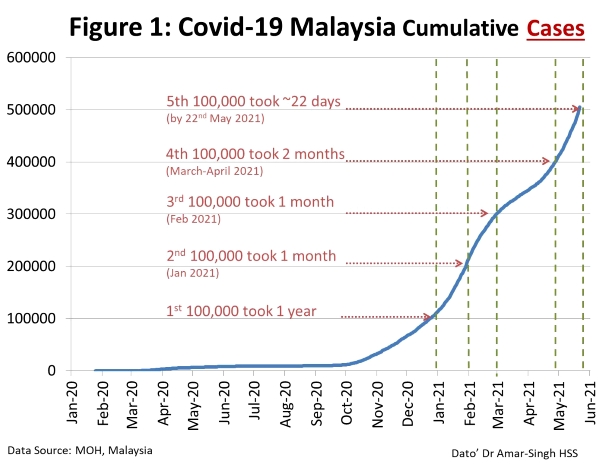
By Dato' Dr Amar-Singh HSS
This article offers some personal insights into the COVID-19 situation in the country.
One concern is that the public in some states behave as though the worsening outbreak is confined to the Klang Valley, or only to selected states. This is a dangerous assumption as the situation is worsening in the whole nation. The lack of adequate data hampers the public's appropriate response to the deepening crisis.
Cases are rising rapidly all over the country
Figure 1 shows how fast our current outbreak is growing. While we took 1 year (2020) to reach 100,000 reported cases, it took only 22 days to achieve the same in May 2021.

We also know from the Ministry of Health (MOH) that clusters are no longer the primary focus as unlinked community spread is huge (On 11th May 2021, the DG of MOH stated that 80% of cases are from the community).
It is important to recognize that numbers reported daily do not give the full picture as our testing is very limited, except perhaps for Selangor state. In the past we averaged 40-70,00 total tests most days and only in the past few days reached 100-110,000 tests per day (114,027 tests on 22nd May 2021 with 5.54% positive). We probably pick up ~25% of cases in the community.
We have little access to testing numbers for each state and that would provide a better idea of what is happening. As an example, if you compare the testing numbers for Selangor and Sarawak for 21st May 2021, you see the large disparity and concerns. Much of the public is concerned with Selangor and think the outbreak is centered there. But note that the testing numbers for Selangor are huge compared to Sarawak and the positivity rate for Sarawak is very high, indicating that testing is grossly inadequate (many positive cases missed).
Hence Selangor gets a 'bad' outlook with many cases merely because they test extensively. Of all states in the country, Selangor perhaps has the most accurate daily reported cases. We should worry about all the other states.
| 21/05/2021 | People Tested | Test Positivity Rate |
| Sarawak | 4,248 | 14.4% |
| Selangor – data represents only 2 districts testing numbers (Gombak, Hulu Langat) by the state government | 19,858 | 5.9% |
ICUs bed occupancy at critical levels nationwide
When reported case numbers are not a good indicator, ICU admission (and deaths) offers us a better understanding of what is happening in each state.
On 21st May 2021 MOH showed data that COVID-19 intensive care (ICU) bed occupancy has increased from less than 200 beds in March 2021 to close to 900 beds on 20th May 2021.
This has only worsened in the past 48 hours. Again there is a perception that this is a Klang Valley problem (DG of MOH showed a table of ICU COVID-19 usage for Klang Valley at 113% on 22nd May 2021). However we have also been made aware that 9 out of 10 ICU beds nationally are occupied.
Some state health departments kindly make available data on ICU bed usage by COVID-19 patients. If you compare that you can see that Malacca is the worst affected state. Sarawak is worse than Perak, even though parts of Perak have been placed under an EMCO order. All states should offer COVID-19 ICU admission rates daily (remember that this will be affected by deaths).
| 22/05/2021 | Covid-19 Patients in ICU |
Covid-19 ICU Admission Rate (per 100,000 population) |
| Malacca | 55 | 5.88 |
| Selangor and WPKL | 377 | 4.53 |
| Sarawak | 85 | 3.01 |
| Perak | 52 | 2.07 |
ICU beds are full (or exceeding 100%) in the Klang Valley, Malacca, Sarawak, Penang, Kelantan, etc. Many private hospital ICU beds are also getting full. In all states MOH 'repurposed' other beds to become ICU beds. Even coronary care unit (CCU) beds are being converted into ICU beds. Some patients are beginning to be ventilated in general wards.
It is critical to remember that ventilation and medical care in a 'repurposed' bed and general bed is very different from what an ICU offers. It is not just the ventilator that is important. There is the medical gas delivery system, all the supportive equipment (monitors, large number of perfusers, specialized bed, etc, etc).
Most importantly is the staffing. If you want to manage critically ill persons you need one to one ICU experienced nursing care round the clock; a commodity that is very hard to find. Hence opening 'new' beds is difficult and 'repurposed' beds and general beds do not offer the same level of care.
Mortality rate is rising
The number of COVID-19 patients dying is rising and the mortality rate is increasing; see Figure 2.

In just the first 18 days of May 2021 we had 500 reported deaths, the same number we experienced in the full year of 2020. To give you a better understanding of this worsening crisis, allow me to use data from Sarawak. From January to April 2021 they reported 161 COVID-19 deaths. However from 1st to 21st May 2021 they had 86 deaths – hence 53% of all their COVID-19 deaths in 2021 (so far) occurred in the past 21 days. The same is happening throughout the nation.
Note that we had averaged a mortality rate of 0.3-0.4%. But from 1st-22nd May 2021 the mortality rate rose to 0.7% (Sarawak's mortality rate for May 2021 was 0.88%).
This reflects our over-run ICUs, possibly more severe variants spreading and the huge size of our undetected pandemic. All states should make available COVID-19 mortality rates by month, so that the public can understand the crisis better and respond appropriately.
Remember also that ICU admissions and deaths lag behind the reported cases by 2-3 weeks. So the situation we are seeing is the reality of what happened in late April to early May 2021. This will worsen in the next few weeks due to the movement during the recent Raya period.
Younger people are dying and mutations spreading
Another changing trend is the increasing numbers of deaths among younger persons. In recent months 20-30% of all deaths are under 60 years of age (36% under 60yrs in Sarawak for January to April 2021).
In addition increasing numbers of individuals are presenting at clinical Stage 4 or 5 (severe disease) which is worrying. This could be due to the increased spread of mutations (especially South African variant) that have been detected in the Klang Valley, Kelantan, Perak, Sarawak, etc.
Our genome testing is limited, but it is likely that a sizable proportion of the current massive outbreak is due to variants.
As it has been recognized, these variants of concern spread easier, are harder to detect/test and cause more severe illness. This may explain the higher numbers, increased ICU beds usage and younger persons dying.
When will the current outbreak peak?
We all want an end to the current large wave but have to realize that it has yet to peak. If we all work together, the current upsurge in cases could possibly peak in 2-3 weeks from now in West Malaysia (maybe last longer). However in Sarawak and Sabah they may see an extended peak to late June or early July due to the impending Gawai and Kaamatan (Harvest) festivals; if these celebrations allow movement of individuals, it will make the current growing outbreak worse.
We must remember this is not the end of outbreaks; sadly there may be more to come. Our vaccination has been limited due to supply issues. We have been informed that the bulk of vaccines will come from July onward (in the second half of the year).
Until we can vaccinate 60-70% of the population, we will be open to more dangerous waves of COVID-19.
What are the implications of these trends? What is possibly going to happen?
1. Quarantine centers are overflowing and we will have to resort to home quarantine to cope. Existing quarantine centers are also far too congested and confined; many shy away from testing as they do not want to be admitted under these conditions.
2. Our ICU beds are already maxed out. Use of 'repurposed' and general bed for ventilation will increase mortality. We can expect more deaths for the next 2-3 weeks. In addition there is the horrible reality on the ground that doctors will have to triage ICU bed access by age and prior chronic illness. We may be frustrated about this but must remember that our health services have been under-funded and under-developed for decades. This has also happened in countries with better health systems like Italy.
3. We will also sadly see an increased mortality in ill patients without COVID. On many 'normal' days, we struggle to find an ICU bed for an ill person. Now with so many ICU beds occupied by patients with COVID-19, those with other health needs that require ICU care will be affected. All states should make available non-COVID-19 mortality rates by month (compared to the pre-COVID era).
What can we do as the general public?
The key is to avoid getting infected with COVID-19. Once infected we run the risk of severe disease and Long COVID (10+% suffer from debilitating and incapacitating symptoms that can persist for months; some with permanent organ damage).
1. Limit all unnecessary contact with others (except the family you live with).
There is no safe number to meet at work, at religious gatherings, socially, at your home, etc. Avoid celebrating any festivals with others outside of your home and avoid any traveling.
2. Work from home (if you can) as much as possible.
No number is safe because of the extensive community transmission. Ideally work to home if possible.
3. Online education for children.
As a pediatrician I am devastated by the damage this pandemic has done to our children, especially with the loss of schooling. But in the current crisis, keeping children at home and continuing their education there is the right move. Many children (40%) have no digital devices. We need to work together to share our pre-loved (old) devices with the community as well as invest in Chromebooks for them (cheaper than laptops).
4. Focus on ventilation in all enclosed spaces.
While we have been concerned with hand disinfection (please continue), we need to strongly emphasize the need to improve the ventilation in all buildings – supermarkets, offices, shops, classrooms, etc.
5. Improve the quality and fit of your mask.
Most individuals wear a 3-ply surgical mask, but this leaks at the side and limits our protection. Look online for good suggestions and videos on improving this. Two quick methods to improve your protection are to tighten your ear loops or wear a cloth mask over the surgical mask.
6. Get vaccinated the moment you have a chance.
While many of us are desperately waiting for our chance to get a vaccine, some who are eligible are hesitant. Please get any vaccine that becomes available, the moment you have an opportunity (including the AstraZeneca roll out). We also need to support old persons in registration, IT access and transport to get vaccinated.
7. Help others.
A significant portion of our public are struggling with daily needs and we need to support them. Please share your resources and wealth.
8. Maintain your personal physical, emotional, mental, spiritual fitness.
Together we will overcome this adversity but we have a long way to go still and need to keep from despair. Maintain good routines to keep you well, not just physically but emotionally and spiritually.
(Dato' Dr Amar-Singh HSS is a Senior Consultant Pediatrician.)
ADVERTISEMENT
ADVERTISEMENT


































